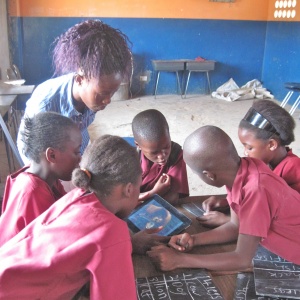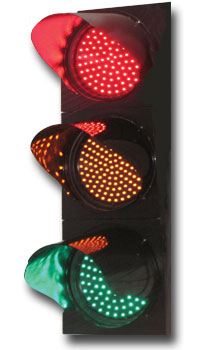OER4Schools/activities/Traffic lights
| Resource details | |
| Title | Traffic lights or Robots in your classroom |
| Topic | [[Topics/OER4Schools|OER4Schools]], [[Topics/Teacher Education Resources for Sub-Saharan Africa|Teacher Education Resources for Sub-Saharan Africa]] |
| Teaching approach | [[Teaching Approaches/|]]
|
| Subject | [[Resources/Teacher Education|Teacher Education]] |
| Age of students / grade | [[Resources/|]]
|
| Related ORBIT Wiki Resources |
|
| Acknowledgement | This resource is part of the OER4Schools programme. |
Traffic lights, also known as robots in southern Africa (or elsewhere as traffic signals, traffic lamps, signal lights, or semaphores), are a useful resource, consisting of three different coloured cards, for everyday use in classrooms in order to assess.
The name "traffic lights" comes from the fact that traffic lights (or robots) are a piece of equipment designed to control traffic flow. Traffic lights have three lights - red, orange and green. These lights signal to drivers what action they should take on the road with each coloured light having a different meaning associated with it: Red means Stop; Orange means Get Ready and Green means Go.
In education, "traffic lights / robots" refers to a set of coloured cards in the classroom, where the colours have meaning as follows:
- a RED card means “I’m stuck. I need some extra help. I don’t feel I have progressed.”
- an ORANGE card means “I’m not quite sure. I need a little help. I feel I have made some progress.”
- a GREEN card means “I understand fully. I’m okay without help. I feel I have progressed a lot.”
Use of robots / traffic lights in the classroom:
- While the teachers are teaching, they can ask students to hold up a coloured card to assess if they should proceed to the next topic or not.
- Students can voluntarily show a coloured card indicating their current level of understanding. They can change the coloured card several times during a single lesson. In this way, the student can bring their understanding to the teacher's notice without disturbing other classmates or the flow of the lesson. Teachers can address the student at an appropriate time.
- While working independently in groups, students can display their coloured card on the table to indicate their current status. Teachers can visit the student to provide assistance.
Eventually students are expected to independently use the coloured cards without the teacher's instruction to do so. The coloured cards of the robot(a)/traffic lights(a) should become a silent way of communicating in the class.
Displaying cards also reduce students' physical stress of standing in queues or raising their hands while waiting for the teacher's attention.
What to call robots / traffic lights in the classroom. Bear in mind that students at deep rural schools may have never seen a robot, and may not be familiar with the concept. Also, the name might vary: In Europe, robots are known as traffic lights whilst in Southern Africa they are commonly referred to as robots. Use the name that will be most familiar to the students in your classroom and explain the concept of the coloured lights and their meaning if necessary.
Use of robots / traffic lights in groupwork: While the teacher needs to know who has understood, it doesn't have to always be the teacher who responds to red or orange cards. Students working in a group can also help each other. In Unit 3 we emphasise that groupwork is most successful when groups themselves are given responsibility for making sure that all members understand. Robot / traffic lights cards can alert students to the need to assist their peers.
One Zambian teacher's reflection on trying out the technique:
- During interactive teaching and learning, pupils in groups work very hard through collaboration in order to get correct answers and display green cards.
- The traffic lights activity worked very well because it made me as a teacher to know whether my teaching was understood or not by seeing the most colour of cards which were displayed. If most of them displayed green then I concluded that teaching and learning took place. If most of displayed red cards, again I could tell that proper learning hasn’t taken place. I thought of using other approach methods to achieve the objectives of learning and teaching i.e. I could emphasis more during conclusion and give home work or give remedial work sometimes as peer assessment.
Suggested follow-up activity: Do the activity of making robot / traffic lights cards with your students.You can be creative about the use of materials depending on availability.


